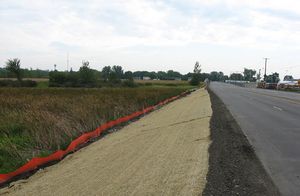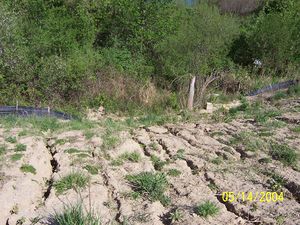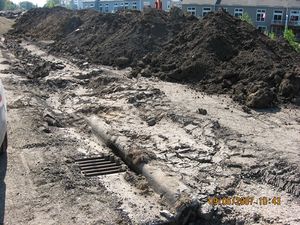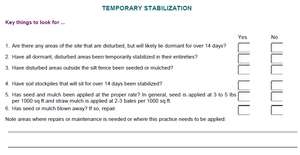
Erosion prevention practices - temporary seeding and stabilization
The Construction General Permit defines stabilization, stabilized, and stabilize as the exposed ground surface has been covered by appropriate materials such as mulch, staked sod, riprap, erosion control blanket, mats or other material that prevents erosion from occurring. Grass, agricultural crop or other seeding alone is not stabilization.
Stabilization includes a wide range of erosion prevention practices that cover exposed soil such as the use of straw, mulch, erosion control blankets, plastic sheeting or tarpaulins. Temporary seeding is a soil stabilization practice involving the establishment of temporary vegetative cover to reduce erosion on construction sites that have disturbed areas that are temporarily idle (i.e., where no soil disturbing activities occur on that portion of the site for 14 or more consecutive days). Erosion prevention practices like stabilization are generally less costly and more effective than sediment control measures, which involve settling or filtering mobilized soil particles before they are transported by runoff to surface waters.
Contents
Purpose and function
Temporary seeding and stabilization are intended to counteract the erosive influences of rainfall, rain and snowmelt runoff, and wind on bare soil. Stabilization prevents the mobilization and subsequent transport of soil particles by preventing erosion. Stabilization practices, which mostly include temporary vegetated cover and the application of a mulch, blanket, mat, or other cover on bare soil, is the easiest, cheapest, and most effective approach for addressing sediment loss (muddy runoff and dust) from construction sites. Since temporary seeding is only effective for erosion control once vegetation has established, mulch or other temporary cover is needed to protect seeded areas until vegetation emerges. A good stand of vegetation will protect soil from erosion by raindrop impact and help slow runoff to prevent rill erosion. The vegetation can also act as a filter, trapping coarse sediment particles carried by runoff.
Applicability
Temporary seeding and stabilization apply to areas of construction sites where soil-disturbing activities have temporarily ceased, and/or immediate measures are needed to prevent erosion and sediment runoff at its source during anticipated rainfall or snowmelt events. Note: Temporary seeding information is presented in this subsection; information on other approaches for temporary stabilization (e.g., blankets, mats, mulches, hydraulically applied products, etc.) can be found in other subsections.
Site applicability
Construction sites often have areas where soil disturbing activities such as clearing, grading, or cut/fill work has stopped for a period of time. Bare areas that are not actively under construction need some type of temporary cover to prevent or minimize erosion in the event of rainfall or snowmelt. Applicable areas include topsoil stockpiles, rough graded areas, sediment basin dikes, ditches, temporary earthen structures, and graded areas undergoing settlement.
Permit applicability
The MPCA Construction General Permit has several requirements regarding temporary stabilization. See Section 8.
- Permittees must stabilize all exposed soil areas, including stockpiles. Stabilization must be initiated immediately to limit soil erosion when construction activity has permanently or temporarily ceased on any portion of the site and will not resume for a period exceeding 14 calendar days. Stabilization must be completed no later than 14 calendar days after the construction activity has ceased. Stabilization is not required on constructed base components of roads, parking lots and similar surfaces. Stabilization is not required on temporary stockpiles without significant silt, clay or organic components (e.g., clean aggregate stockpiles, demolition concrete stockpiles, sand stockpiles) but must provide sediment controls at the base of the stockpile.
- For Public Waters that the Minnesota DNR has promulgated "work in water restrictions" during specified fish spawning time frames, permittees must complete stabilization of all exposed soil areas within 200 feet of the water's edge, and that drain to these waters, within 24 hours during the restriction period.
- Other permit requirements exist during the construction of post-construction/permanent stormwater and temperature control BMPs discharging to special waters and impaired waters. In those cases, Permittees must immediately initiate stabilization of exposed soil areas, as described in item 8.4, and complete the stabilization within seven (7) calendar days after the construction activity in that portion of the site temporarily or permanently ceases.
- Finally, it shall be noted that stabilization requires more than seed alone. Section 25 of the 2018 MPCA Construction Stormwater General Permit states: "Stabilize", "Stabilized", "Stabilization" means the exposed ground surface has been covered by appropriate materials such as mulch, staked sod, riprap, erosion control blanket, mats or other material that prevents erosion from occurring. Grass seeding, agricultural crop seeding or other seeding alone is not stabilization. Mulch materials must achieve approximately 90 percent ground coverage (typically 2 ton/acre). [Minn. R. 7090]
Effectiveness
Temporary seeding and stabilization is effective in reducing soil loss from construction sites once vegetation has become established. As the following table shows, vegetative cover can reduce erosion by up to 99 percent with the application of mulch at the MPCA recommended rate of two tons per acre. Because seeding is only effective after plants have emerged, the application of straw mulch or other cover is required at the time of seeding. Erosion prevention practices such as seeding and mulching are generally more effective and less expensive than sediment control practices.
Bare soil cover types and percent reduction of soil loss. The C factor, used to determine the relative effectiveness of soil and crop management systems in terms of preventing soil loss, is a ratio comparing the soil loss from land under a specific crop and management system to the corresponding loss from continuously fallow and tilled land. Source: Northwest California Resource Conservation and Development District 2016.
Link to this table
| Vegetative Cover | C factor | Percent reduction of soil loss |
|---|---|---|
| None (fallow ground) | 1.0 | 0 |
| Native vegetation (undisturbed) | 0.01 | 99 |
| Temporary tyegrass, 99% (perennial) | 0.05 | 95 |
| Temporary ryegrass, 90% (annuals) | 0.1 | 90 |
| Permanent seedings (90%) | 0.01 | 99 |
| Sod (laid immediately) | 0.01 | 99 |
| Mulching (for slopes 2:1 or less) | ||
| Hay (0.5 tons/acre) | 0.25 | 75 |
| Hay (1.0 tons/acre) | 0.13 | 87 |
| Hay (1.5 tons/acre) | 0.07 | 93 |
| Hay (2.0 tons/acre) | 0.02 | 98 |
| Wood chips (6 tons/acre) | 0.06 | 94 |
| Wood cellulose (1.75 tons per acre)X | 0.10 | 90 |
| Other | ||
| Competent gravel layer | 0.05 | 95 |
| Rolled erosion control fabrics | (for slope greater than 2:1) | Variable C value by type |
The following table summarizes expected performance for an array of typical water quantity and quality target constituents for temporary seeding and stabilization practices. Once established, a good stand of vegetation will protect soil from erosion by raindrop impact and help slow runoff to prevent rill erosion. The vegetation can also act as a filter, trapping coarse sediment particles (and associated pollutants, including nutrients and some heavy metals) carried by runoff.
Expected performance for temporary seeding and stabilization practices
Link to this table
| Water Quantity | |
|---|---|
| Flow attenuation | Little or no design benefit |
| Runoff volume reduction | Secondary design benefit |
| Pollution prevention | |
| Soil erosion | Primary design benefit |
| Sediment control | Secondary design benefit |
| Nutrient loading | Primary design benefit |
| Pollutant removal | |
| Total suspended solids | Primary design benefit |
| Total phosphorus | Primary design benefit |
| Heavy metals | Secondary design benefit |
| Floatables | Little or no design benefit |
| Oil and grease | Little or no design benefit |
Planning considerations
Erosion prevention through soil stabilization is always preferred over sediment control, due to cost and overall effectiveness considerations. However, because of the nature of the work, erosion prevention is not always feasible on active construction sites. When a disturbed area will be inactive for a prolonged period, erosion prevention measures are typically required. Areas left undisturbed over the winter should also be temporarily seeded and stabilized.
Temporary seeding is an effective erosion prevention practice that primarily uses the quick emergence of annual seedlings to stabilize bare soil surfaces. As such, proper seedbed preparation and the use of quality seed are important for good germination and growth. A poor stand (less than 50 percent cover) will not provide adequate erosion prevention.
A key planning objective involves the minimization of bare soil footprints at the site, followed by the immediate stabilization of inactive areas through temporary seeding or other measures until the next phase of construction begins. Planning and staging projects in a manner that minimizes the extent and duration of soil disturbance helps to reduce both erosion and sediment loss. In practice, this often means scheduling operations to complete clearing, grading, and cut/fill operations in a phased manner, so that disturbed areas can be stabilized (either temporarily or permanently) as the project proceeds. Planning approach examples include the following.
- Subdivision development – complete clearing, grading, and primary road layout, then temporarily seed and mulch home site and secondary road locations until construction begins in those areas.
- Commercial projects – immediately seed and mulch graded building footprint(s) and proposed landscaped areas, then focus construction and material storage on areas immediately adjacent to the building pad(s). Parking lots can be graveled and used for material storage, staging, and parking.
- Institutional and manufacturing facilities – same as commercial projects. Keep activities close to the vertical construction site, minimize disturbed areas, and temporarily seed idle areas.
Outside contractors are not typically required for temporary seeding and stabilization. Keeping the specified seed, straw mulch, rolled erosion control products, and other materials on hand ensures that temporary seeding is implemented timely and efficiently. High priority areas for immediate stabilization include areas within 100 feet of a lake, river, stream, or wetland; slopes steeper than 4H:1V; and ditches and channels within 200 feet of a waterbody or property line.
The current list of MnDOT certified/approved vendors for seed are available on MnDOT's website.
Design
Key design parameters for temporary seeding include: 1) the desired length of time for stabilization; 2) the appropriate type of seed or seed mix; 3) the rate of seed application; 4) the time of year in which the seed is planted; and 5) the type of mulch, blanket, or other material used to cover the site and support the emergent vegetation. Additional design considerations include the following.
- Select a seed type or mix appropriate for the length of time that temporary stabilization is needed. Annual seeds will die off at the end of the growing season and must be re-seeded to maintain vegetative cover. Perennial seeds will result in grass that persists for many growing seasons, and should be used where temporary cover is needed beyond the late fall and winter periods. Annual seed is often planted in combination with perennial seed to provide quick stabilization and help establish the longer-maturing plants.
- Select seeds that sprout quickly and are effective and economical in providing temporary cover (see the table below that describes seed mixture selection and other information for various construction site stabilization periods.
- Calibrate the seed application rate based on the type of terrain to be seeded. For example, steep slopes, buffers next to surface waters, and flow channels require a denser stand of grass than flat areas.
- Straw mulch applied at two tons per acre is typically used to provide immediate cover and support emerging grass, although erosion control blankets and other options are available depending on site conditions.
Seed mixture selection and other information for various construction site stabilization periods
Link to this table
| Seed/Mixture Name and Planting Season | MnDOT Mixture # | Common Name | Scientific Name | Rate (lb/acre) | % of Mix (by weight) |
|---|---|---|---|---|---|
| Oats One Year Cover Crop May 1 – August 1 | 21-111 | Oats | Avena sativa | 100.00 | 100.00 |
| Total | 100.00 | 100.00 | |||
| Winter Wheat One Year Cover Crop August 1 – October 1 | 21-112 | Winter Wheat | Triticum aestivum | 100.00 | 100.00 |
| Total | 100.00 | 100.00 | |||
| Soil Building One Year Cover Crop May 1 – August 1 | 21-113 | Field Pea | Pisum sativum | 50.00 | 45.46 |
| Oats | Avena sativa | 60.00 | 54.54 | ||
| Total | 110.00 | 100.00 | |||
| One to Two Year Stabilization April 1 – July 20 July 20 – October 20 | 22-111 | Slender Wheatgrass | Elymus trachycaulus | 9.00 | 29.50 |
| Perennial Ryegrass | Lolium perenne | 4.50 | 14.76 | ||
| Alfalfa | Medicago sativa | 8.50 | 27.86 | ||
| Red Clover | Trifolium pratense | 8.50 | 27.88 | ||
| Total | 30.50 | 100.00 | |||
| Two to Five Year Stabilization April 1 – July 20 July 20 – October 20 | 22-112 | Perennial Ryegrass | Lolium perenne | 13.50 | 33.75 |
| Smooth Brome | Bromus inermis | 6.00 | 14.99 | ||
| Slender Wheatgrass | Elymus trachycaulus | 2.00 | 5.01 | ||
| Big Bluestem | Andropogon gerardii | 0.50 | 1.25 | ||
| Alfalfa | Medicago sativa | 8.50 | 21.25 | ||
| Red Clover | Trifolium pratense | 5.50 | 13.74 | ||
| Alsike Clover | Trifolium hybridum | 3.50 | 8.75 | ||
| American Vetch | Vicia americana | 0.50 | 1.26 | ||
| Total | 40.00 | 100.00 | |||
- After selecting the appropriate type of seed, prepare the seedbed by tilling to a minimum depth of 3 inches. In compacted or hard soils, it may be necessary to use a disc, ripper or other relatively heavy tillage equipment to help prepare the seedbed. On sloped sites, all equipment activities (including disking, ripping, or tilling) should be performed by across the contour (versus up and down slope) to help minimize rill erosion. Where large soil clods are present, rolling or cultipacking may be required before seeding to ensure uniform seeding depths and good seed/soil contact. Do not prepare areas for seeding under excessively wet conditions.
- If a soil test confirms a need for fertilizer or liming, apply the recommended amount and incorporate it into the top 2 to 4 inches of soil during seedbed preparation. Use a slow-release fertilizer to minimize the chance for nutrient runoff into surface waters. Test for presence of agricultural chemicals (e.g., herbicides, pesticides) if using topsoil from farmland; methods may include conducting bioassays or sending samples to a laboratory for chemical analysis (e.g., EPA methods for laboratory analysis of soil samples include EPA Methods 8081 and 8141 for pesticides and EPA Method 8151 for herbicides).
- Check seed distribution equipment on a smaller test area of known dimensions prior to seeding the site by comparing weight of seed dropped/broadcast versus the test area covered, and calibrate if necessary. Apply seed evenly with a cyclone seeder, drill, cultipacker seeder, or with a hydroseeder. Small grains and grasses should be planted no more than 0.5 inch deep.
- Consider seeding at a lower rate and making two passes to ensure adequate coverage. Do not seed when conditions are wet. Use a cultipacker or other roller to lightly but firmly press soil around seed.
Summary of seeding methods and related information for temporary stabilization
Link to this table
| Method | Site Applications | Site Preparation | Equipment | Mulch Type |
|---|---|---|---|---|
| Drop seeding | Prepared seed beds | Loosen topsoil to a depth of at least 3 inches; leave rough | Drop seeder, followed by cultipacker | Punched-in straw; erosion blanket |
| Broadcast seeding | Prepared seed beds | Loosen topsoil to a depth of at least 3 inches; leave rough | Mechanical cyclone attachment or hand seeder | Punched-in straw; erosion blanket |
| Hydroseeding | Steep slopes and other inaccessible areas; wetland and pond edges | Loosen topsoil to a depth of at least 3 inches; leave rough; avoid hot and dry conditions | Hydroseeder with fan-type nozzle; 500 gallons of water per acre | Bonded fiber matrix; cellulose hydromulch; punched-in straw |
| Inter-seeding | Poorly / sparsely vegetated areas; areas of poor past seeding/germination | Mow existing vegetation; kill broadleaf weeds | Inter-seeding drill with trash ripper, followed by cultipacker | Not required, but recommended for steeper slopes |
- Cover slopes steeper than 3H:1V with an erosion control blanket. If seeding is being done in a temporary ditch or swale that will receive moderate water flows during the stabilization period, it is recommended that a straw/coconut blanket be used to cover the seed. Other more severe situations such as very steep slopes and/or channels exposed to high water velocities will require more specialized treatments.
- In general, slopes that are 3H:1V and flatter should be mulched with a clean grain straw or native grass mulch and disc anchored following seeding. Mulching should attempt to achieve 90 percent or greater coverage of the exposed soil surface. This generally requires about 2 tons per acre of straw mulch. If possible, use a high quality weed free mulch such as MCIA Certified Weed Free mulch or a native prairie grass mulch.
- For areas seeded during the dormant period (i.e., when soils are too cold for germination), broadcast seed after soil temperature at a depth of one inch below the surface are at or below 40 degrees. Different species of grasses will be dormant at different times of the year and will not germinate. Forbs should be installed in the fall, because they need to go through a freeze/thaw cycle prior to germination. Where erosion or wind is a concern, cover seeded areas with mulch or blankets if possible; plan to interseed (i.e., with an interseeding drill) in the spring.
- Mark off and post signs around seeded areas to keep vehicles, equipment, livestock, and foot traffic away. Provide alternative traffic routes and parking to ensure seeded area remains protected.
Standards and specifications
MnDOT Specification 2575.3 parts A and B (pages 502 to 504) include guidance for temporary seeding, including seeding dates for various MnDOT seed mixtures, site conditions requiring temporary seeding, and application methods. Part K.3, which covers maintenance of seeded areas, states: “Repair damage within the area caused by Contractor operations and within the Contractor‘s control at no expense to the Department. Reseed areas where the original seed has failed to grow, as directed by the Engineer.”
Specification 2575.4 (pages 510, 511) prescribes requirements for measurement of seed and seeding. Seed should meet Specification 3876 (“Seed”; pages 666-669). Table 3876-1 prescribes standard seed mixes and pure live seed (PLS) application rates (lb/acre)
Inspection and maintenance
Inspect areas immediately prior to seeding to ensure that the seedbed is properly tilled (i.e., down to at least 3 inches), roughened so that seed can fall into the spaces between the soil particles, and free of large rocks, woody debris, litter, etc. Inspect again immediately after seeding and mulching for proper coverage and cultipacker (or other roller) results. The seedbed should be lightly compacted, to maximize seed-to-soil contact.
After seed emergence, check for vegetation density and note any bare or sparse areas. Monitor vegetation growth during the first two to five weeks, especially during dry conditions. If the seeding fails to grow, it may need to be re-established to provide adequate erosion prevention. Document any areas that need to be inter-seeded or reseeded, and areas where undesirable vegetation is emerging. Noxious weeds may need to be controlled by mowing or spraying.
MnDOT’s workmanship and rework schedule (2016; version under development at the time of manual update) identifies common deficiencies for various types of stabilization BMPs – including seeding – and corrective actions for these deficiencies. Once complete, the full, final version of this table will replace Table 2575-4 in MnDOT Standard Specifications for Construction (2016 edition).
Table 2575-4: Required corrective action
Link to this table
| Item | Corrective Action Required if: | Corrective action |
|---|---|---|
| Seeding |
|
|
Maintain downgradient sediment controls (e.g., silt fence, fiber rolls) until dense vegetation with uniform coverage is established. Irrigate seeded areas with portable, overhead sprinklers if dry conditions hinder germination or early growth. Cover bare or sparse areas with mulch until they can be reseeded or inter-seeded, which should be done at the earliest opportunity. Mow dense stands of undesirable species that shade out planted areas. Hoe or spot spray weeds as needed. During the first year of establishment, do not mow seedlings until after they are at least 6 inches tall while leaving a minimum height of 3 inches.
An example inspection checklist for temporary stabilization practices is shown on the right (Source: Ohio EPA]).
Costs
The following table summarizes estimated BMP costs based on MnDOT data summarizing average bid prices for awarded projects in 2014. (See subsequent sections for cost information on related erosion control products to provide protective cover such as mulch, erosion control blankets, etc.).
Average seeding bid prices
Link to this table
| Bid Item | Item Description | Units | Average Price |
|---|---|---|---|
| 2575.501/00010 | Seeding | acre | 💲190.70 |
| 2575.502/21111 | Seed Mixture 21-111 | lb | 💲1.57 |
| 2575.502/21112 | Seed Mixture 21-112 | lb | 💲1.89 |
| 2575.502/21113 | Seed Mixture 21-113 | lb | 💲3.37 |
| 2575.502/22111 | Seed Mixture 22-111 | lb | 💲2.34 |
Reference materials
Except where more stringent requirements are presented in this guidance, BMPs shall comply with MnDOT and other state requirements. Primary design references include:
- MnDOT Erosion Control Handbook II
- Minnesota Urban Small Sites Best Management Practice Manual (Vegetative Methods)
- 2018 Minnesota NPDES/SDS Construction Stormwater General Permit
- MnDOT Seeding Manual, 2014 Edition. Office of Environmental Stewardship, Erosion Control Engineering Unit. http://www.dot.state.mn.us/environment/erosion/pdf/seedingmanual.pdf
- MnDOT Standard Specifications for Construction
The following is a list of additional resources that are not specific to Minnesota:
- Clark County Washington Stormwater Manual (BMP C120: Temporary and Permanent Seeding)
- Clean Water Services Erosion Prevention and Sediment Control Manual (4.1.8 Seeding (Temporary/Permanent)
- North Carolina Erosion and Sediment Control Planning and Design Manual (6.10 Temporary Seeding)
- Northwest California Resource Conservation and Development District. 2016.5C Program Stormwater Management Handbook.
- Ohio EPA (Ohio Environmental Protection Agency). 2016. Construction Site Inspection Checklist for OHC000004.
- Tennessee Department of Environment and Conservation (TDEC) Erosion and Sediment Control Handbook (7.8 Temporary vegetation)
- Virginia Erosion and Sediment Control Handbook (3.31 Temporary Seeding)
- Wisconsin Department of Natural Resources. Seeding for Construction Site Erosion Control (1059).
Related pages
- Erosion prevention practices
- Erosion prevention practices - temporary seeding and stabilization
- Erosion prevention practices - natural and synthetic mulches
- Erosion prevention practices - tackifiers and soil stabilizers
- Erosion prevention practices - erosion control blankets and anchoring devices
- Erosion prevention practices - turf reinforcement mats
- Erosion prevention practices - Riprap
- Sediment control practices
- Sediment control practices - Vehicle tracking BMPs
- Sediment control practices - Perimeter controls for disturbed areas
- Sediment control practices - Check dams (ditch checks, ditch dikes)
- Sediment control practices - Diversion barrier controls (cofferdams/temporary dikes)
- Sediment control practices - Storm drain inlet protection
- Sediment control practices - Outlet energy dissipation
- Sediment control practices - Sediment traps and basins
- Sediment control practices - Stabilized earth/soil berm
- Construction stormwater treatment - dewatering, including chemical treatment and sediment filtration
- Construction stormwater best management practice – buffer zones
- Other practices
This page was last edited on 11 January 2023, at 17:41.




